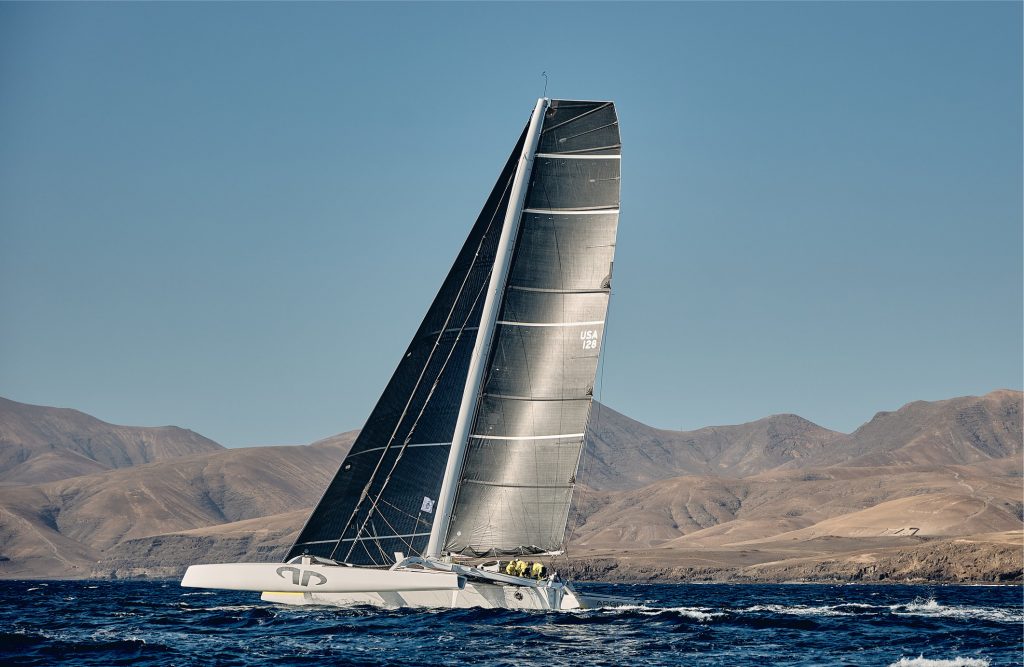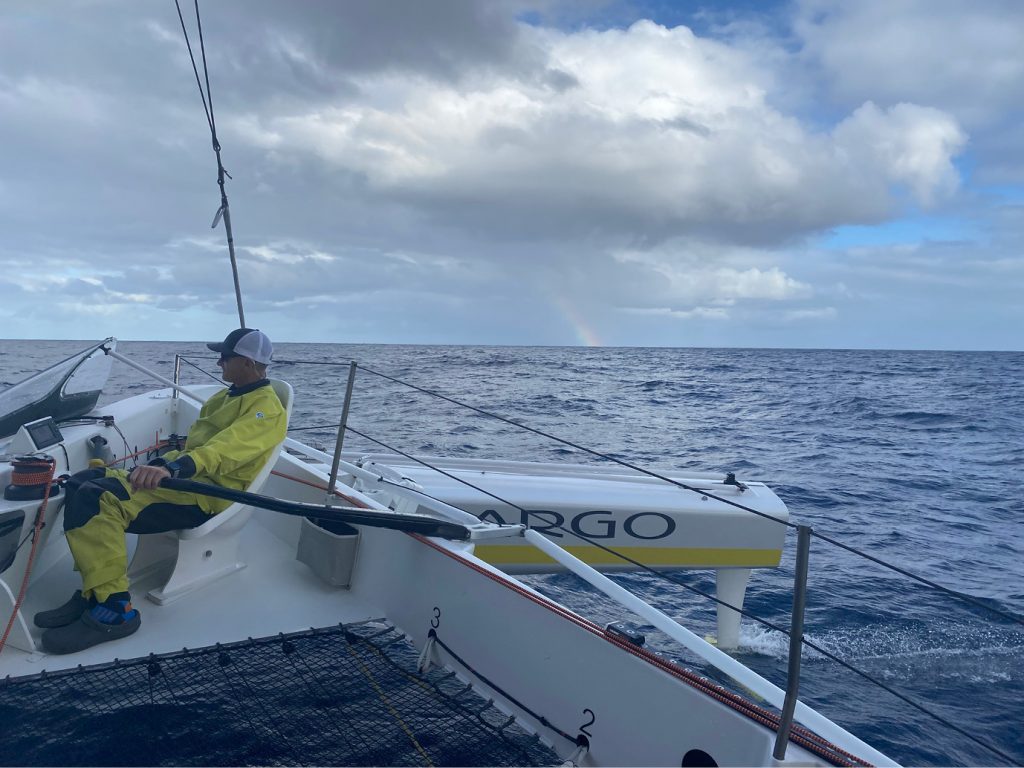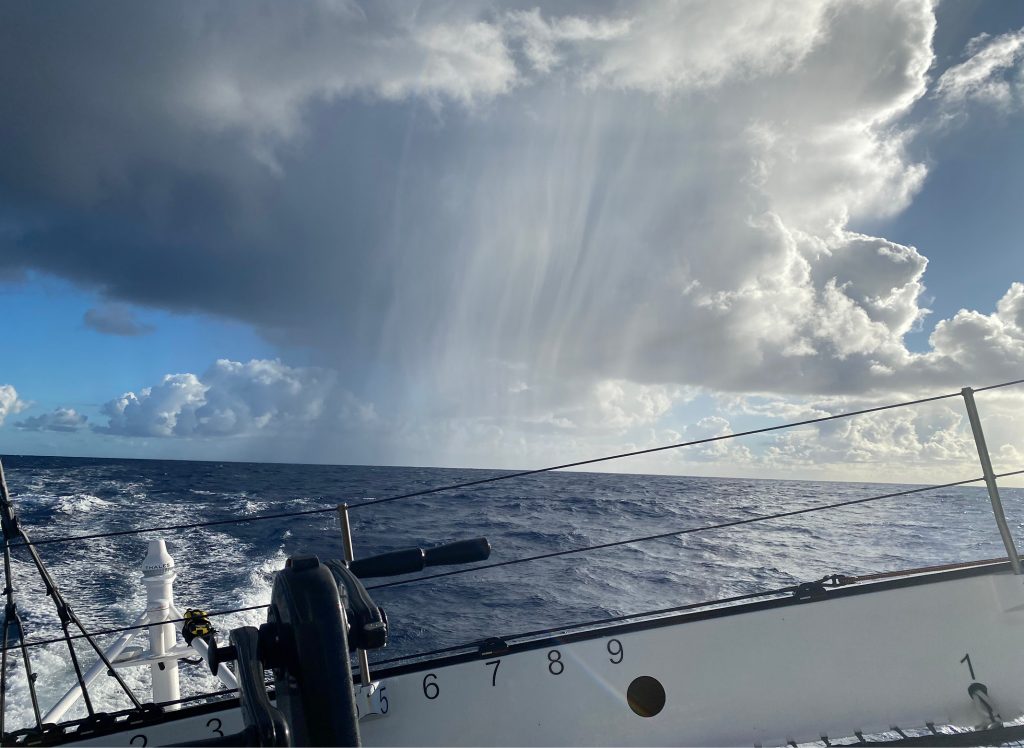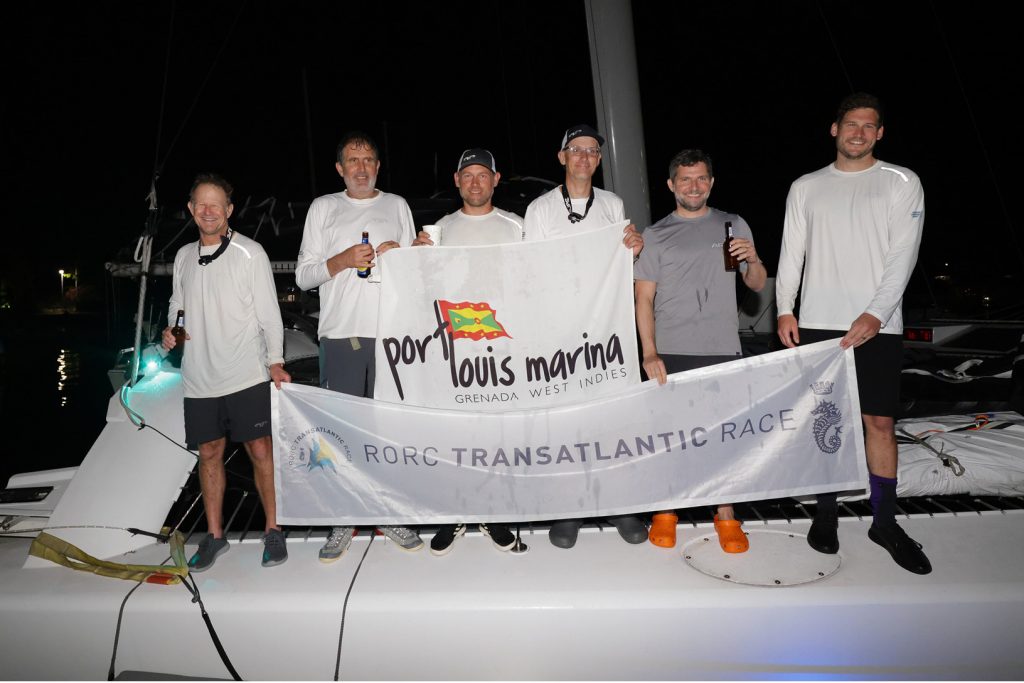The 2022 RORC Transatlantic Race
By Chad Corning, Argo Racing Program Manager

Argo blasts along the coast of Lanzarote after the start. © RORC/James Mitchell
The Royal Ocean Racing Club’s Transatlantic Race was first run in 2014 and has increased in popularity over the years. Why wouldn’t it? It’s a beautiful racecourse starting from the stark, volcanic Canary Islands and ending 3,000 miles across the Atlantic at the island of Grenada. A record fleet of thirty yachts (that’s a lot for a race this long) took part in 2022. On paper it’s a VMG downwind sail almost all the way, as you can hook into consistent Tradewinds almost immediately after clearing the Canaries.
Unfortunately, the Tradewinds were disrupted this year by a strong cold front/low pressure system that had dumped snow on the Northeast U.S. after New Year’s and then headed out to sea. This system was a major factor in how yachts approached the race strategically. You could opt for light winds and an easier passage by staying south, or go for a quicker (but much rougher) trip by heading to the north to punch through the front and get in stronger winds more quickly. Either way, the usually reliable Tradewind pattern would not re-establish until much later in the race.
We were excited to take on the challenge aboard Jason Carroll’s MOD 70 trimaran Argo (New York, NY). After a successful 2021 season, including a world record North Atlantic passage and a new outright record in the Rolex Middle Sea Race, we were firing on all cylinders and ready. Argo was refitted with lifting foils and t-rudders in 2021, which made the boat a lot more stable and easier to push. We had a team of six for the race: Jason Carroll, myself, Brian Thompson, Alister Richardson, Henry Bomby and Charlie Ogletree. Such a small team makes maneuvers challenging but ultimately is the right move as being light pays significant dividends on a long race. We would have excellent competition in Maserati and Powerplay, both sistership MOD 70s, as well as Ultime Emotion, an 80-foot trimaran much in the mold of the MODs.

Author Chad Corning, outpacing rainbows at the helm. © Argo Racing
The race started downwind off the city of Lanzarote on January 8, in 20 knots of wind. As usual, all the MODs were keen at the start and we all sailed down the east coast in close company. Once clear of the southern tip of the island, everyone laid their strategy cards on the table and headed downwind to the northwest. OK, looks like option B – rough trip and punch through the front!
The first 24 hours of the race were lively, with winds in the 20-25 knot range and a very stacked up three-meter sea state. The three MOD 70s were glued to one another and our feet were firmly smashed on the accelerator for this first portion of the race. We all sailed almost 700 miles through the water in the first 24 hours. Unfortunately, Ultime Emotion had a gennaker lock failure soon after the start and would not feature in the battle, though they did repair and rejoin the race ten hours later.
The pace of the first 24 hours was fairly unsustainable, but Mother Nature helped us pump the brakes with lighter airs as we got closer to the front. Day two was spent in mostly 8-10 knots of wind with very unfavorable angles in terms of closing distance to the finish. The day was largely about setting up where we wanted to intersect the front. We had a setback with a significant impact on the starboard rudder occurring during the day, but after stopping to inspect all seemed OK. Our navigator Brian Thompson opted for the most northern option of the three MODs and we were frankly glad when the rolled line of clouds appeared on the horizon and we could get it over with. It was as advertised with massive amounts of precipitation and fresh, gusty winds. We sailed through with three reefs and the storm jib, and had no issues. Certainly the power of the ocean was on full display here and that was awesome to experience.
Once through the western wall of the front we got the payoff; strong winds from the NNE that would allow us to rip directly at the finish for the first time in the race. There was a price to pay however as the sea state whipped up by the front was very confused, sometimes breaking and up to four meters in height. So we danced the delicate dance of pushing for speed but not breaking the yacht in the big seas. Manageable during the day, but a much more dicey prospect at night.
After making steady progress during day three, we heard an ominous crack from the starboard t-rudder and watched as the bottom portion broke away. No immediate danger in the big conditions as the port rudder was shouldering the load (we were on starboard), but this damage would make the yacht much harder to control on port. Certainly the rudder (now nicknamed “stubby”) had been compromised from the impact earlier on day two. We adopted a flatter sailing style on port to ensure the central rudder stayed in the water as the stub of the starboard rudder was ineffective on its own if you ended up flying the central hull. We missed dearly the elevator or “T” on the starboard rudder, as it provided the pitch control to balance out the boat as it flies on the starboard foil.
Day four brought more light air as the fresh winds generated by the front subsided and the Tradewinds fought to reestablish themselves. As with earlier in the race the light air was a welcome respite after the frenetic pace after passing the front. Incredibly all three MOD’s were fairly close together at this point, 20 miles in distance to the finish covered all of us. Positioning was key at this point at we all dove south to meet up with the building Tradewinds which would propel us to the finish.
Finally on day five, the wind we had been longing for filled in and we had the orderly downwind sailing (with a nice, organized swell) that the race is famous for. I can’t fail to mention the whales (mother and offspring) that swam with us for a while (at 25 knots!) and then disappeared only to spectacularly breech just a few lengths behind us. You could feel the energy through the boat as she swam to the surface and fully breeched with a twist. Even the Russian judge gave her high scores.
With a faint whiff of Grenada in our nostrils the intensity increased and the three MODs drew closer together. Incredibly, after 2,500 miles of sailing and sometimes broadly divergent strategies we all came together and started crossing jibes within sight of one another. Race on!
The last 24 hours of the race was a pressure cooker as each boat had their turn being in the lead. We were glued like kids to Tik-Tok to the position reports that came through every three hours. Due to our northern approach to Grenada, the island of Barbados – about 150 miles east of Grenada – was inconveniently in the way. This forced a choice: sail extra miles to the north of the island for a potentially better angle into the finish, or stay south on a more direct route with more forecasted wind. Powerplay and ourselves stayed south, while Maserati rolled the dice from third and opted for the northern option. They were rewarded handsomely, as conditions went their way and they surged into the lead. Being over 75 miles south of them, there was no way to cover off the move and by the time we got the position report after the split we knew it was checkmate.

Squalls were a big deal once Argo got into the tropics. Close to the downwind edge was the preferred positioning. © Argo Racing
In the end, only three hours covered the MOD 70s after almost seven days of racing. We were circumspect about the result. We pushed hard, sailed with some damage and were still in with a shot at winning right until the end. That’s all you can ask from a competitive standpoint, and the sense of accomplishment after a safe and fast trip across more than compensated for the slight disappointment of the result. Celebrating on the dock afterwards with our fellow competitors eased the last sting of disappointment right off the radar.

The crew celebrates at Camper & Nicholsons Port Louis Marina. © RORC/Arthur Daniel
After 24 hours in Grenada, we hit the road again for Antigua where the boat got a deserved rest before taking on the Caribbean 600 on February 21. The same four big multihulls will complete and we’re expecting another nail-biter. Post-600, Argo will be back home in Newport to take on the outright Newport Bermuda Record as well as the Newport Bermuda Race in June. ■
A professional sailor, program manager, build manager and coach, Chad Corning is a two-time Melges 32 National Champion, two-time Viper 640 National Champion, Shields National Champion, and Melges 32 European Champion.



